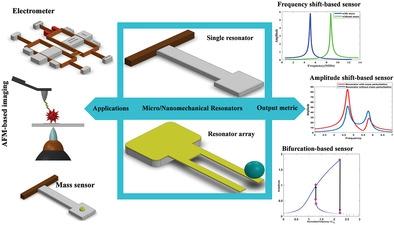当前位置:
X-MOL 学术
›
Adv. Electron. Mater.
›
论文详情
Our official English website, www.x-mol.net, welcomes your
feedback! (Note: you will need to create a separate account there.)
A Comprehensive Categorization of Micro/Nanomechanical Resonators and Their Practical Applications from an Engineering Perspective: A Review
Advanced Electronic Materials ( IF 5.3 ) Pub Date : 2022-07-27 , DOI: 10.1002/aelm.202200229 Narjes Ghaemi 1 , Amin Nikoobin 1 , Mohammad Reza Ashory 1
Advanced Electronic Materials ( IF 5.3 ) Pub Date : 2022-07-27 , DOI: 10.1002/aelm.202200229 Narjes Ghaemi 1 , Amin Nikoobin 1 , Mohammad Reza Ashory 1
Affiliation

|
Micro/nanoelectromechanical systems (M/NEMS), especially micro/nanomechanical resonators, provide an unprecedented platform for investigating a wide range of applications in both fundamental physical phenomena (such as quantum-level problems) and engineering and applied sciences (like sensing physical quantities and signal processing). In sensing context, these tiny resonators are invaluable tools for detecting weak forces and single molecules. Measuring such small variations in sub-nanometer amplitudes at high frequencies has created many practical challenges. Therefore, maximizing the responsivity to a specified input parameter and minimizing the responsivity to other inputs such as noise are considered as the optimal design for the excellent performance in nanoresonators. The present review aims to summarize some of the recent progress in this rapidly advancing field. Specifically, more attention is paid to the topics related to the dynamical behaviors of micro/nanoresonator and their practical applications. First, the theory behind micro/nanoresonators is described. Then a summary is presented of the basic concepts in resonant devices. In addition, several commonly dynamical techniques to enhance sensitivity are introduced. Finally, the devices are classified based on linear and nonlinear, single and array, symmetric and asymmetric, and frequency shift-based and amplitude shift-based resonators, along with the relative advantages and disadvantages of each one in engineering applications.
中文翻译:

从工程角度对微纳机械谐振器及其实际应用进行综合分类:综述
微/纳机电系统 (M/NEMS),尤其是微/纳机械谐振器,为研究基本物理现象(如量子级问题)和工程和应用科学(如传感物理量)中的广泛应用提供了前所未有的平台和信号处理)。在传感环境中,这些微型谐振器是检测弱力和单分子的宝贵工具。在高频下测量亚纳米幅度的如此微小变化带来了许多实际挑战。因此,最大化对指定输入参数的响应度并最小化对其他输入(例如噪声)的响应度被认为是纳米谐振器优异性能的最佳设计。本综述旨在总结这一快速发展领域的一些最新进展。具体而言,更加关注与微/纳米谐振器的动力学行为及其实际应用相关的主题。首先,描述了微/纳米谐振器背后的理论。然后总结了谐振器件的基本概念。此外,还介绍了几种提高灵敏度的常用动态技术。最后,根据线性和非线性、单个和阵列、对称和非对称、基于频移和基于幅移的谐振器对器件进行分类,以及每种谐振器在工程应用中的相对优缺点。更多关注与微纳谐振器的动力学行为及其实际应用相关的主题。首先,描述了微/纳米谐振器背后的理论。然后总结了谐振器件的基本概念。此外,还介绍了几种提高灵敏度的常用动态技术。最后,根据线性和非线性、单个和阵列、对称和非对称、基于频移和基于幅移的谐振器对器件进行分类,以及每种谐振器在工程应用中的相对优缺点。更多关注与微纳谐振器的动力学行为及其实际应用相关的主题。首先,描述了微/纳米谐振器背后的理论。然后总结了谐振器件的基本概念。此外,还介绍了几种提高灵敏度的常用动态技术。最后,根据线性和非线性、单个和阵列、对称和非对称、基于频移和基于幅移的谐振器对器件进行分类,以及每种谐振器在工程应用中的相对优缺点。介绍了几种提高灵敏度的常用动态技术。最后,根据线性和非线性、单个和阵列、对称和非对称、基于频移和基于幅移的谐振器对器件进行分类,以及每种谐振器在工程应用中的相对优缺点。介绍了几种提高灵敏度的常用动态技术。最后,根据线性和非线性、单个和阵列、对称和非对称、基于频移和基于幅移的谐振器对器件进行分类,以及每种谐振器在工程应用中的相对优缺点。
更新日期:2022-07-27
中文翻译:

从工程角度对微纳机械谐振器及其实际应用进行综合分类:综述
微/纳机电系统 (M/NEMS),尤其是微/纳机械谐振器,为研究基本物理现象(如量子级问题)和工程和应用科学(如传感物理量)中的广泛应用提供了前所未有的平台和信号处理)。在传感环境中,这些微型谐振器是检测弱力和单分子的宝贵工具。在高频下测量亚纳米幅度的如此微小变化带来了许多实际挑战。因此,最大化对指定输入参数的响应度并最小化对其他输入(例如噪声)的响应度被认为是纳米谐振器优异性能的最佳设计。本综述旨在总结这一快速发展领域的一些最新进展。具体而言,更加关注与微/纳米谐振器的动力学行为及其实际应用相关的主题。首先,描述了微/纳米谐振器背后的理论。然后总结了谐振器件的基本概念。此外,还介绍了几种提高灵敏度的常用动态技术。最后,根据线性和非线性、单个和阵列、对称和非对称、基于频移和基于幅移的谐振器对器件进行分类,以及每种谐振器在工程应用中的相对优缺点。更多关注与微纳谐振器的动力学行为及其实际应用相关的主题。首先,描述了微/纳米谐振器背后的理论。然后总结了谐振器件的基本概念。此外,还介绍了几种提高灵敏度的常用动态技术。最后,根据线性和非线性、单个和阵列、对称和非对称、基于频移和基于幅移的谐振器对器件进行分类,以及每种谐振器在工程应用中的相对优缺点。更多关注与微纳谐振器的动力学行为及其实际应用相关的主题。首先,描述了微/纳米谐振器背后的理论。然后总结了谐振器件的基本概念。此外,还介绍了几种提高灵敏度的常用动态技术。最后,根据线性和非线性、单个和阵列、对称和非对称、基于频移和基于幅移的谐振器对器件进行分类,以及每种谐振器在工程应用中的相对优缺点。介绍了几种提高灵敏度的常用动态技术。最后,根据线性和非线性、单个和阵列、对称和非对称、基于频移和基于幅移的谐振器对器件进行分类,以及每种谐振器在工程应用中的相对优缺点。介绍了几种提高灵敏度的常用动态技术。最后,根据线性和非线性、单个和阵列、对称和非对称、基于频移和基于幅移的谐振器对器件进行分类,以及每种谐振器在工程应用中的相对优缺点。











































 京公网安备 11010802027423号
京公网安备 11010802027423号